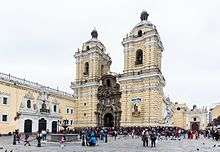Monastery of San Francisco, Lima




Convento de San Francisco is the Spanish name for Saint Francis Monastery located in Lima, Peru , south of Parque la Muralla and one block northeast from the Plaza Mayor. The church and convent are part of the Historic Centre of Lima, which was added to the UNESCO World Heritage List in 1991. Aside from a church and monastery it also contains a library and catacombs. In this church, Jude the Apostle is venerated. At the feast of Saint Jude Tadeus a one and a half ton weighing silver stand is carried round in procession by 40 people, starting from the convent.
Architecture
The church and monastery were blessed in 1673 and completed in 1774. Though it survived several earthquakes intact in 1687 and 1746, it suffered extensive damage in an earthquake in 1970. The church is noted for its architecture, a high example of Spanish Baroque. Its granite carved portal would later influence those on other churches, including the Church of Merced. The vaults of the central and two side naves are painted in mudejar style: a mix of Moorish and Spanish designs. The main altar is totally made from wood. The halls of the head cloister are inlaid with Sevillian glazed tiles dating from the 1620s. The complex is made of the temple, the convent and two other churches, 'La Soledad' and 'El Milagro'.
Convent
The convent's library is world-renowned. It possesses about 25,000 antique texts, some of them predating the conquest. Some notable books are the first Spanish dictionary published by the Royal Spanish Academy and a Holy Bible edition from 1571- 1572 printed in Antwerp.
Other notable possessions are 13 paintings of the biblical patriarch Jacob and his 12 sons in the refectory, by the hand of the studio of the Spanish master Francisco de Zurbarán. The last supper painted by Diego de la Puente depicts typical Peruvian ingredients and meals, instead of European dishes it depicts, such as guinea pig, potatoes and chillis. Also peculiar is the Devil hovering besides Judas. The monastery also possesses several paintings attributed to the school of Peter Paul Rubens.
The convent originally included seven cloisters (the main courtyard, St. Bonaventure, St. Francis Solanus (who is buried in the monastery church), the Pepper Yard, the Infirmary, the Novitiate and the Third Order). During the works to open Abancay Avenue in the 1940s, part of the monastery (including St. Bonaventure's courtyard) was demolished, and the section used by the Franciscan Third Order was separated from the main structure.
Another cloister, that once belonged to the Franciscans, was given to the Society for Public Welfare around 1847 and became part of the Ruiz Dávila Hospice. Another part of the complex is now used by the Peruvian National Police.
Catacombs

Discovered in 1943, they contain thousand of skulls and bones, having served as a burial-place until 1808, when the city cemetery was opened outside Lima. It is estimated that 25,000 bodies were laid to rest there; the crypts, built of bricks and mortar, are very solid and have stood up well to earthquakes, it is also believe there existed secret passageways that connected to the Cathedral and the Tribunal of the Holy Inquisition.
Bibliography
- GUIDE TO PERU, Handbook for travelers, 6th. Edition, by Gonzalo de Reparaz Ruiz, Ediciones de Arte Rep, Lima - Perú, Book edited in English language by the Fondo de Promoción Turística del Perú - FOPTUR.
- Peru, Lonely Planet, edition 2010
- Lima - San Francisco Monastery and Church, Planetware
- Iglesia de San Francisco, Lima , Sacred Destinations
- The Franciscan Monastery official site in English
PACHECO, Ana Assis, «Convento franciscano de Lima: uma obra seiscentista de um engenheiro e arquitecto português», in ITINERARIUM, ANO LV, Nº 194, Maio-Agosto 2009.
See also
| Wikimedia Commons has media related to San Francisco de Asis (Lima). |
Coordinates: 12°02′43.79″S 77°01′38.62″W / 12.0454972°S 77.0273944°W
